Big Blue World
The Global Newsletter of the Society for Underwater Technology Issue 13, March 2025














The Global Newsletter of the Society for Underwater Technology Issue 13, March 2025














Chair
Welcome to the first issue of Big Blue World for 2025. Without tempting fate with the bad weather demons, winter is almost behind us here in Scotland. As we rush into spring, I can reflect on the hectic start we’ve had to the year.
Since taking over as Chair of the Aberdeen branch, we have held our annual quiz night and AGM, a business breakfast, two evening meetings, supported Subsea Expo, and organised a careers event in collaboration with SUT+ colleagues and Aberdeen University—all within just two months! It has been a very active start, and one I have certainly enjoyed.
I have witnessed first-hand the ability of the SUT family to bring together people from all generations. Our February branch meeting focused on saturation diving—an aspect of our underwater capabilities that is often taken for granted. It was our best-attended meeting since lockdown, drawing a great crosssection of individuals, from industry veterans keen to reconnect with peers to early-career professionals eager to expand their knowledge. I was particularly struck by the speaker from Boskalis Subsea Services, who delivered an enlightening presentation on how modern medical practices have been adapted to enable divers to perform effective CPR in the cramped confines of a diving bell at depth. Remarkably, this technique had remained unchanged in diver training for almost 70 years. The fact that such a potentially life-saving method had been overlooked for so long serves as a reminder that we can always learn from others.
With the SUT branch well established in the Aberdeen area for over 30 years, we benefit from a strong committee and the continued support of our corporate members. However, like most other regions, we find ourselves navigating several transitions. Regardless of political sentiment, the energy transition is clearly upon us. We must balance the underwater aspects of our hydrocarbon legacy with an increasing focus on renewable technologies. I believe this presents a fantastic opportunity for our sector to thrive, with the Society playing a key role as an educational champion.
Another transition we are experiencing locally is generational. An industry that grew from strength to strength in the ’90s and early 2000s is inevitably seeing experienced practitioners retire, creating space for younger professionals to step up, bringing fresh perspectives and renewed vigour to shape the Society’s future.
As Chair of the branch, I find myself at the heart of both transitions—too old for late nights but not yet ready for pasture! Despite losing some of our more seasoned committee members, we have successfully recruited younger members who are active in both oil and gas and renewables, ensuring a strong and balanced future for the branch.
In this issue of Big Blue World, you’ll find a diverse range of articles that highlight the multi-faceted nature of the underwater sector and the importance of maintaining a mindset of continuous learning.


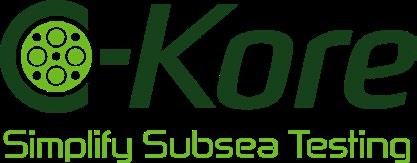
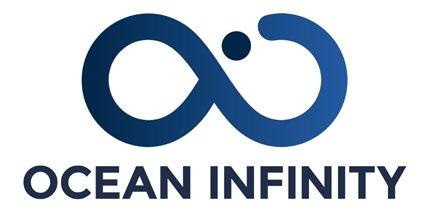

Click the icons above to follow SUT HQ on social media. Join us on LinkedIn! www.linkedin.com/company/sutuk/
Many of our branches and special interest groups also have social media accounts of their own. Make sure you search for ‘Society for Underwater Technology’ on LinkedIn to follow accounts dedicated to these groups too.








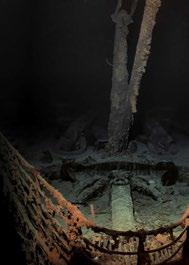







SUT-US Networking Event
3 April 2025
Union Kitchen, Houston, TX, USA
SUT-US OSIG presents: Seabed Considerations for Subsea Cables in Offshore Wind Development – Session 1
8 April 2025
Webinar, Houston, TX, USA
Ocean Business
8-10 April 2025
National Oceanography Centre, Southampton, UK

Women in Marine Networking Lunchat Ocean Business
9 April 2025
National Oceanography Centre, Southampton, UK
Doing Business in Defence - at Ocean Business
9 April 2025
National Oceanography Centre, Southampton, UK
The Role Of Insurance In A Risk Management Strategy - at Ocean Business
10 April 2025
National Oceanography Centre, Southampton, UK
Perth – April Evening Technical MeetingAdvances in ROV Technologies
9 April 2025
Parmelia Hilton Perth, WA
ECOSIGG Networking Evening
10 April 2025
Waxy O’Connor’s, Glasgow, UK
SUT-US OSIG presents: Seabed Considerations for Subsea Cables in Offshore Wind Development – Session 2
15 April 2025
Webinar, Houston, TX, USA
Aberdeen Evening Meeting - Autonomous Underwater Vehicle Operations
16 April 2025
Aberdeenshire Cricket Club, Aberdeen, UK
SUT-US YP & WIND present: AI for Offshore Energy
17 April 2025
Great Heights Brewing Co., Houston, TX, USA
Offshore Wind Renewable Energy Course
29 April - 1 May 2025
Royal Station Hotel, Newcastle, UK
Perth – Subsea Awareness Course
5-9 May 2025
Parmelia Hilton Perth, WA
Aberdeen Evening Meeting - Electrification of Subsea Production Facilities
14 May 2025
Aberdeenshire Cricket Club, Aberdeen, UK
All-Energy
14-15 May 2025
SEC, Glasgow, UK

An Introduction to Offshore Geophysics & Geotechnical Engineering
20-21 May 2025
University of Southampton, UK
Aberdeen Subsea Awareness Course
2-6 June, 2025
Palm Court, Aberdeen, UK
Perth Subsea Production Systems Course
4 June, 2025
Perth, WA
Perth - June Evening Technical Meeting
11 June, 2025
Parmelia Hilton Perth, WA
Find more information on SUT events and training online at www.sut.org/events


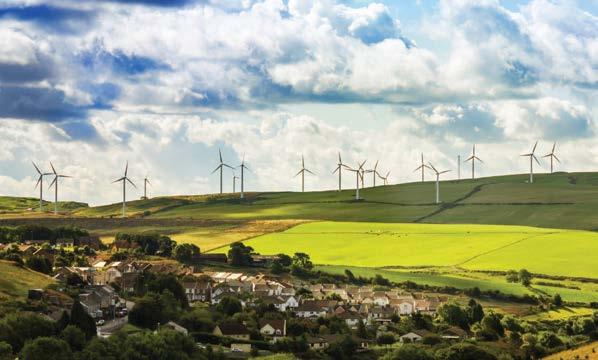
JOIN THE UK’S LARGEST CLEAN ENERGY EVENT.
All-Energy is the ultimate platform for renewable energy professionals, bringing together the entire clean energy community to share ideas, discover innovative solutions, and shape the future of sustainability.
Gain invaluable insights into renewable energy from industry-leading conference speakers.
Discover the latest innovations and solutions driving progress in the renewable energy sector.
Connect with industry leaders and suppliers across the entire clean energy supply chain.




Free registration for All-Energy 2025 (SEC Glasgow, 14-15 May) is at www.all-energy.co.uk/bbw and encompasses the major exhibition, the world-class conference, and the Giant Networking Evening, of which the Civic Reception forms an integral part. SUT, the event’s Learned Society Patron, exhibits on Stand A45.
The government’s Clean Power 2030 mission lies at the conference’s heart, indeed Chris Stark, the mission’s lead, is a plenary session speaker. SUT members will find offshore wind and marine renewables sessions abound in the main conference. Clean Power 2030 Commissioner and OWGP Chair, Tim Pick, will be a lunchtime attraction on day two.
Topic titles speak for themselves. First offshore wind – ‘Offshore Wind 2024: A Year in turmoil – How do we get back on track?’; ‘Are we there yet? The long port infrastructure journey’; ‘Floating wind: A strategic opportunity for the UK’s clean power future’ (with Green Volt the focus of attention); ‘Powering Safety: Energise your workforce with the next evolution in safety’; ‘Harnessing Ocean Renewable Energy’ (in two parts); and ‘Working together to deliver Net Zero’ the session focusing on the work of the Scottish
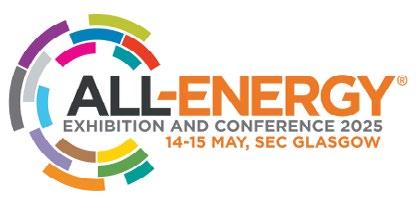
Government’s Marine and Offshore Wind Directorates. Check out the North Sea Transition Authority’s ‘Solving Rubik’s Cube: Maximising the potential of the offshore energy sector’.
Marine renewables sessions see the UK Marine Energy Council focus on ‘Bridging the water: Making the transition to a commercial marine energy industry’; Prof Deborah Graves, SUT Lennard-Senior Prize 2024 winner chairs ‘Meeting UK Government ORE targets and the role of Marine Energy Research and Innovation in tackling the key challenges’; and ‘Marine energy in Scotland: What’s all the comm-ocean?’: Tidal range once again has a whole session.
SUT’s Hon Secretary, a past Chair of Council and President, Dave Brookes, who leads the SUT offshore wind energy training course, hosts a morning-long series of presentations and panel discussions on the work of the Offshore Renewable Energy Catapult (OREC) on 15 May in the Wind show floor theatre. These cover ‘Moorings and Cables: Requirements, Analyses and Dependencies’; and ‘Technology and Components: Developing and emerging solutions’.
See you there!





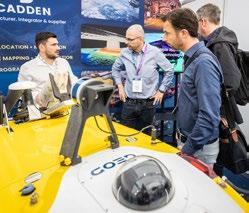


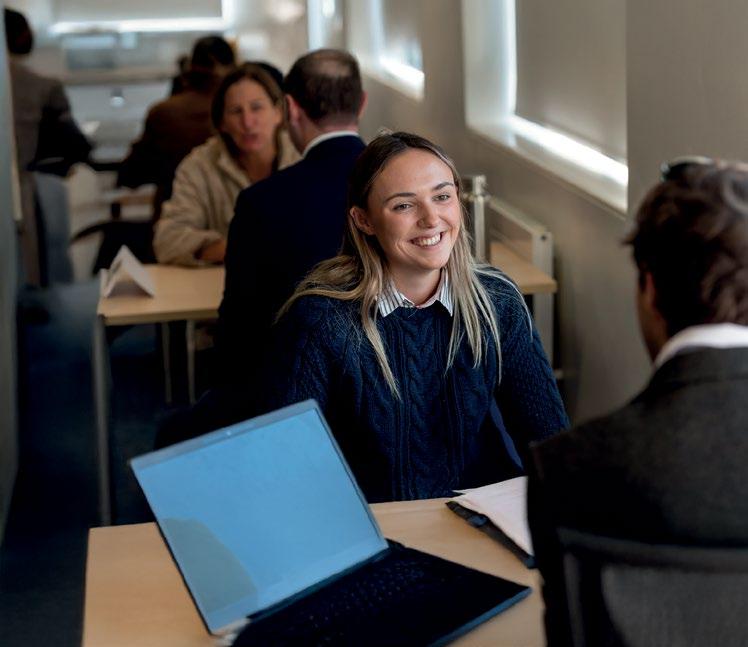
The Strategic Framework mentioned in the SUT Annual Report 2023-2024 has been completed. The Strategic Framework will guide the Society’s future growth in the service of its member and in line with its charitable aims. There are no quick or simple solutions to the challenges the SUT will face in the coming years. Nonetheless, we view the future aware of the possibilities, the potential and the importance of the sectors which SUT engages in for the future of the ocean and us all.
The Strategic Framework document is be available to download via the SUT website. Click here to get your copy.
We wish to thank all of those who volunteered and participated in the Strategy Working Group.

We’d like to welcome to the team: Clare Parisi who joined in July 2024 as Events & Training Officer; Katie Fearon who joined in November 2024 as Administrator and is now our Marketing & Communications Officer; Michelle Jones who joined in March 2025 as Publications & Web Officer and will be working for SUT for the next year as maternity cover for Emily Boddy.
Welcome to the team!




Michelle Jones
Publications & Web Officer
clare.parisi@sut.org
michelle.jones@sut.org
katie.fearon@sut.org



Aberdeen, February 2025 | Cheryl Burgess
The Subsea Expo took place at P&J Live in Aberdeen in February. For SUT it was an opportunity to talk marine, subsea and underwater technology while meeting both existing members exhibiting and visiting the event highlighting the potential of the Blue Economy sectors, as well as students, those speaking in the conference and friends old and new. It was a particular pleasure to welcome students to the SUT stand. A careers clinic was available to university attendees, which attracted undergraduates from the University of Aberdeen and Strathclyde University. SUT also took place on the student trail which had younger students participating in the Subsea Expo inspiring the next generation to have an up close and in-person experience showcasing the career potential in the underwater sectors. The visiting school groups had questions to ask at each stand on the trail. Students visiting the SUT stand were asked, ‘Who was Cornelius Drebble’? For those who haven’t been on the SUT Subsea Awareness Course (SAC), Cornelius Drebble built the world’s first practical and working submarine in 1620 under the patronage of James 1st of England.
We are already looking forward to Subsea Expo 2026.



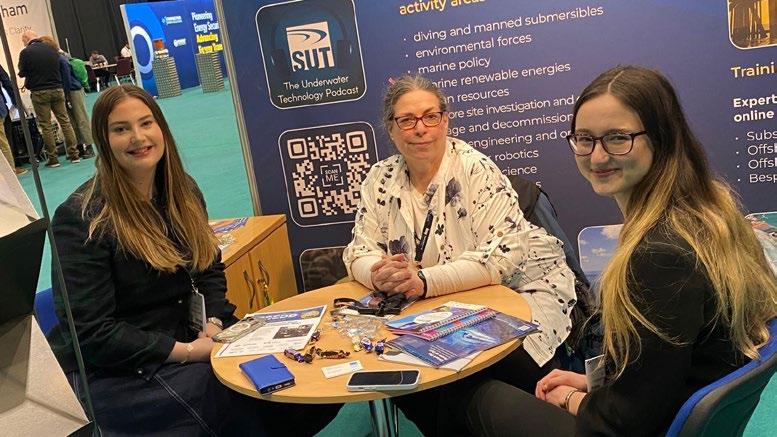



The SUT Subsea Awareness Course was successfully conducted in Aberdeen in early February 2025 and welcomed delegates from around the world.
This course continues to draw professionals eager to gain insight into the unique challenges of the subsea industry, learning from experts with extensive experience and knowledge.
A standout feature of the SUT offering is the opportunity for site visits, where delegates can experience subsea equipment firsthand. These visits provide a deeper understanding of the size, complexity, and intricacies involved in the design, manufacturing, installation, and
operation of subsea technologies.
The site visits were supported by SUT sponsors, including Baker Hughes, where participants had the chance to observe subsea trees and wellheads; SLB Subsea, showcasing control systems; and Fugro, offering insights into intervention challenges and the future of remote operations. On the final day, delegates visited the UK National Decommissioning Centre, where they explored future challenges and experienced the benefits of operational simulations in their state-of-the-art, fully immersive, four-operator interactive simulator. This course is held in Aberdeen four times a year.
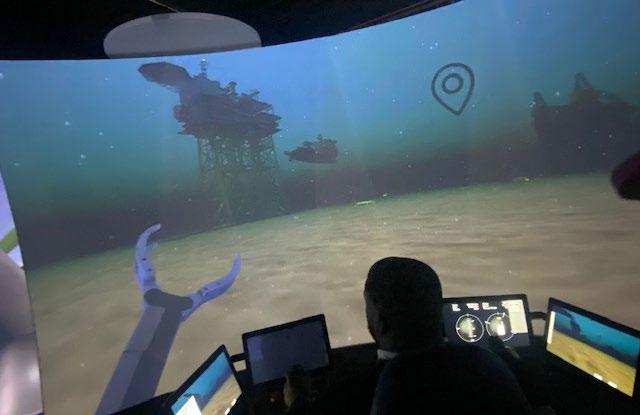



A new AI method pioneered by OnDeck can find and understand anything in underwater footage, just like a human. Peer-reviewed and published at NeurIPS 2024, the software allows users to search across any type of camera or environment - without requiring labelled training data. Offshore industry and subsea technology companies can leverage this system to automate all video and imagery analysis, streamlining decision-making for site investigations, impact assessments, infrastructure
inspections, exploration, and more. This breakthrough was supported by $1.5M from National Geographic, Schmidt Marine, and Canada’s Ocean Supercluster to tackle long standing challenges in automating vision across dynamic underwater conditions.
The online research preview is free to use through April via OnDeck Fisheries AI’s website.




Following success with its onshore/topside valve release service, CONSUB is excited to announce the imminent launch of a new subsea valve release capability, to bring the proven technology below the waterline.
With pressures on the energy sector the CONSUB Field Services team has delivered success for clients on numerous offshore and onshore valve release projects, both UK and globally. This inspired CONSUB to adapt their tool design to take the seized valve release service subsea.
Throughout 2024, the expertise of the CONSUB Centre of Excellence for Valves was regularly called upon. Stuck or seized valves proved to be an issue for many operators, particularly on late-life infrastructure in the UK Continental Shelf. Reliable operation of valves is critical: any loss in functionality is a concern for safety and operational efficiency.
A recurring theme was the impact of an inoperable valve on isolations and planned shutdowns. Even the most comprehensive shutdown plans are worthless
if a valve will not actuate on demand. All too often this leads to an expansion in required isolations, bringing cost, safety and process implications.

However, developments and innovations in the field of valve remediation offered a beacon of hope. With the CONSUB Valve Release System (C-VRS), the team deployed to facilities on numerous occasions to restore the functionality of safety critical valves.
The mechanical C-VRS is safe to use in hazardous environments and requires no process isolations. The amount of torque applied is low, controlled and limited, meaning the tool is “Valve Safe”. Previously inoperable valves have been entirely remediated, axing the scope and impact of process isolations, and bringing significant financial savings.
The team is excited to launch a subsea, diver-operated variant of the C-VRS to remediate stuck valves in the subsea environment.

Wednesday 5th February was a remarkable day for Capt. Mike Meade, CEO of M3 Marine Group. A highly respected maritime professional, Capt. Mike holds prestigious titles, including Fellow of The Nautical Institute (FNI), Chartered Master Mariner (CMMar), and Freeman of The Honourable Company of Master Mariners (HCMM).
In a special ceremony at the Guildhall in London, Capt. Mike was officially admitted as a Freeman of the City of London at the Chamberlain’s Court. This historic recognition, steeped in tradition, is an honour granted to individuals who have demonstrated
exceptional contributions to their profession and the wider community.
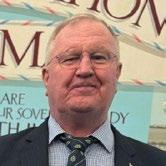
Later that day, Capt. Mike’s achievements were further celebrated when he was “clothed into Livery” at the Court of HCMM by Master Les Chapman. This marks his full induction as a Liveryman of HCMM, solidifying his esteemed standing within the maritime industry.
At M3 Marine Group, we couldn’t be prouder of Capt. Mike for these outstanding milestones. His dedication, leadership, and commitment to the maritime profession continue to inspire us all. Congratulations, Capt. Mike!

We’re thrilled to announce the return of the Autonomous Marine Technology Conference (AMT) in 2025!
l Mark your calendar for three exciting days of innovation and networking:
l Ice-Breaker Event: Tuesday, 28 October 2025
l Conference Day 1: Wednesday, 29 October 2025
l Conference Day 2: Thursday, 30 October 2025
Join us in Perth, Western Australia, to explore cutting-edge advancements in marine technology, network with industry leaders, and dive into thought-provoking discussions.
The AMT Conference, formerly the Autonomous Underwater Technology Conference, is globally recognised as a premier event in the field. It provides a platform to:
l Showcase the rapid evolution of autonomous marine technologies.
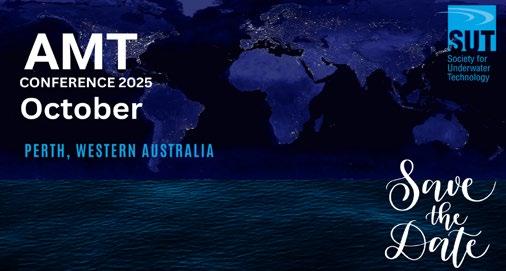
l Highlight real-world applications and future potentials.
l Gain insights from industry leaders, academics, and researchers.
l Advance your professional development with case studies and the latest innovations.
Stay tuned on our LinkedIn, Twitter or keep an eye on your inbox for updates about this upcoming event! CLICK HERE for more information.
Tidal energy remains a significantly under-utilised renewable energy resource, despite the UK possessing up to half of Europe’s exploitable tidal resources. Wales, with its abundant tidal range potential and existing industrial capabilities, is uniquely positioned to spearhead the development of tidal lagoon power stations. These systems offer a predictable and renewable energy source that can complement the intermittent generation of wind and solar energy. Recent advancements highlight the potential for optimising tidal lagoon designs and operational strategies to enhance energy yields and economic attractiveness.
However, existing studies reveal a gap in evaluating the long-term operational benefits of flexible schemes and co-location with other renewable sources. Furthermore, understanding the hydrodynamic interactions between multiple lagoons and their response to climate change scenarios remains a critical research need. Addressing these gaps is essential to maximising the economic, environmental, and energy potential of tidal lagoon projects.
Intertek Metoc has partnered with ORE Catapult and Cardiff University on the Welsh Government’s Tidal Lagoon Challenge project to assess the long-term value of tidal lagoons, focusing on their integration into future decarbonised energy networks and exploring their role in addressing dynamic electricity demand and pricing structures.
Commissioned in mid 2024, this study aims to make tidal lagoon systems in Wales more economically attractive, focusing on three case studies: the North Wales Tidal Lagoon, Cardiff Tidal Lagoon, and Newport Tidal Lagoon as shown on the map. Configuration
optimisation has been carried out to refine design parameters, including turbine types (comparing the Andritz Hydro three-blade turbine and the Tidetec turbine), turbine diameters, turbine numbers, installed capacities, and sluicing areas. Operation optimisation has been achieved using genetic algorithms to explore flexible operation schemes that significantly enhance energy output and economic performance.
Traditionally, the operational heads are set as a pair of constant values for flooding and ebbing tides during spring and neap tides. This may result in a loss of tidal power if the water head difference inside and outside the lagoon is insufficient to reach the set head, particularly during neap tides. The flexible operation schemes use optimisation methods to apply variable operational heads for each tidal cycle, fully exploiting the potential of tidal power to achieve multiple objectives, including maximising energy generation.
For example, in the case of the North Wales Tidal Lagoon, the results indicate that optimisation significantly increases the estimated energy generation by up to 40%. The study further employs two-dimensional (2D) Delft3D modelling to simulate hydrodynamic interactions between the Cardiff and Newport lagoons, verifying the 0-D optimisation results.
Additionally, this project investigates the longterm performance of these systems under climate change scenarios for the years 2035, 2085, 2135, and 2185, providing insights into future resilience and adaptability. The outcomes of this modelling will subsequently be used to evaluate the supply chain and economic aspects. This study underscores the



potential of tidal lagoon developments in enhancing energy generation, storage, and economic benefits, fostering a sustainable and resilient energy future for the UK and beyond. The optimisation results demonstrate that configuration optimisation and flexible operation schemes (including pumping) can significantly increase energy output, making tidal lagoons more economically attractive.
Simulating climate change scenarios helps to better understand the long-term feasibility of these systems,
addressing uncertainties associated with sea level rise and hydrodynamic behaviour. By analysing cost benefits, hydrodynamic interactions, and future adaptability, this research supports the strategic design and deployment of tidal lagoons, contributing to energy security, carbon reduction, and local economic development. The findings will provide essential evidence for developing policy frameworks and cost mechanisms to incentivise tidal range projects in the UK.


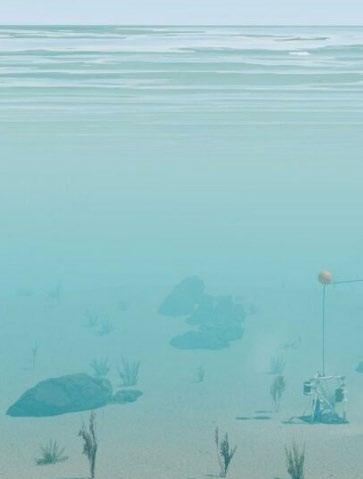

To advance deepwater soundscape exploration, Kaustubha (Kaus) Raghukumar of Integral Consulting Inc. is leading a research team from SEATREC Inc., Proteus Technologies LLC, Monterey Bay Research Institute, the Naval Postgraduate School, and the Scripps Institution of Oceanography to develop and demonstrate the first ever autonomous, near real-time, directional acoustic profiling float powered by marine renewable energy.
The underwater soundscape consists of a complex mix of physical, biological, and anthropogenic sources that often have very different characteristics. While most sounds are well-characterized on continental shelves and near populated regions, there is a marked paucity of acoustic data at full
The NoiseSpotter
ocean depths, primarily due to the logistical challenges in deploying and recovering traditional acoustic sensing platforms in difficult-to-reach regions of the world’s oceans. This project will result in a near real-time, ocean thermal energy conversionpowered, directional acoustic profiling float navigated using ocean model output for explorations of the ocean through persistent, long-endurance, deep-water ocean acoustic observations. Directional profiling float measurements will consist of acoustic pressure and particle motion at low- to midfrequencies relevant to many biological and physical processes, anthropogenic sources, and geophysical processes, along with complementary physical oceanographic parameters.
The NoiseSpotter® features a small (4 × 4 × 4-ft) three-sensor array, with each sensor measuring acoustic pressure and particle velocity to geolocate sources of sound more efficiently. Each sensor is housed inside a flow noise suppression shield to improve signal-to-noise for collection of robust acoustic data in energetic conditions.
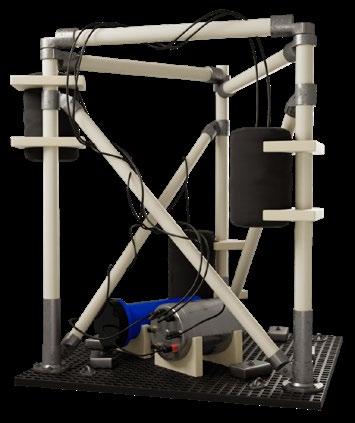



The Seatrec infiniTE™ float with directional acoustic sensor prior to deployment during the project’s year one fieldwork. The float is powered using an ocean thermal energy conversion system (OTEC). At the heart of OTEC is a phase-changing material that undergoes a volume expansion over a 10° C (50° F) temperature range, which drives a turbine that can then recharge the float batteries, thereby providing unlimited power for float operations. Image courtesy of Autonomous, Directional Acoustic Profiling Float for Soundscape Characterization

A GROUNDBREAKING global developer and provider of borehole geophysical and petrophysical logging technologies and services is moving to a new headquarters and planning further expansion.
Award-winning Robertson Geo will relocate from its sites in Deganwy and Llandudno to a new 20,500 square-foot building on Tre Morfa Enterprise Park, Conwy, following significant growth.
In addition to extensive manufacturing facilities, offices, meeting rooms, and a training hub, the base will be home to a world-class calibration facility, a “beacon of best practice” for the multiple sectors it operates in, including offshore wind, mining and minerals, geotechnical, renewables, water and environmental, and energy petrophysics.
They also plan to take up further rented space on the park for the firm’s expanding Robertson Geo Services operational team.
Managing Director Simon Garantini said the business - which also has locations in the US and Hong Kong –will be sorry to leave its existing premises after more than 45 years, but he and the 55-strong workforce are looking forward to the “next chapter”.
“We have outgrown our current facilities and would have moved earlier if not for the pandemic, but this is the right time and we aim to be in by the summer,” said Simon.
“Relocating to Conwy means our UK team will all be on one site, and the new base will set the standard for the industry.
“We have always been leaders in technology development, calibration, validation, and compliance, so this will further enhance our strengths and future-proof the organisation.
“It also means we will be in a position to steadily double our head count and sales revenue, which is up 15-20% year on year.”


He added: “It’s taken some time for us to get to this point, but we are pleased to start this next chapter and will be looking to take on more manufacturing and field operations staff this year to meet global demand for our Marine Geotechnics division, which is focused on offshore wind.”
With customers in 160+ countries and more than 25 approved agents, Robertson Geo provides ground investigation services and manages borehole logging equipment rentals worldwide.
As well as management of services and administration, the new base will be home to the firm’s design, manufacturing, sales and assembly staff.
Simon revealed it will also include the RG Academy, a world-leading training centre that will welcome people to North Wales for a range of bespoke courses.
“This is the perfect building to achieve our vision and capitalise on the opportunities we have in multiple arenas the world over,” he said.
“We do cover a broad range of sectors and have seen an increase in customers internationally, notably in the US and Asia, but also want to help develop and train the next generation of workers in these industries, which is why we continue to invest in our people and the latest, cuttingedge technology.
“It’s an exciting time for Robertson Geo, there is so much in the pipeline here in North Wales and especially on the international stage, so we’re looking forward to the future.”

“We
have always been leaders in technology development, calibration, validation, and compliance.”
Aberdeen-based digital transformation consultancy Core29 has won a six-figure contract with an international marine protection organisation.
The OSPAR Commission, which represents 15 national governments and the EU, has awarded Core29 the contract to design a database to monitor and report on marine pollution into the North-East Atlantic.
Delivered in collaboration with Peterson Solutions’ aquaculture sustainability consultancy team, the 10-month project will deliver a new database for OSPAR’s Riverine Inputs and Direct Discharges (RID) programme.
The programme monitors discharges of contaminants from rivers into tidal waters or directly into the sea in the OSPAR Maritime Area and its regions. The 15 governments involved are Belgium, Denmark, Finland, France, Germany, Iceland, Ireland, Luxembourg, The Netherlands, Norway, Portugal, Spain, Sweden, Switzerland and United Kingdom.
Core29 managing director Alan Dick said:
“The combination of Core29’s database experience with Peterson Solutions’ extensive aquatic expertise means our partnership is uniquely positioned to develop and maintain a new database that will meet the evolving needs of OSPAR.
“We have put considerable effort into understanding OSPAR’s requirements to make sure we deliver a comprehensive, high-quality solution tailored to meet their very specific legislative and reporting needs.
“The new technology will allow OSPAR to better consolidate and understand its data and make it much easier to provide analytics and insights that are helpful to users, whether governing, environmental or regulatory.”
Dominic Pattinson, Executive Secretary at the OSPAR Commission, said:
“We are looking forward to working with Core29 to update our previous system and improve the use of this important database to inform evidence-based policy decisions.
“The database performs an important function in assessing and monitoring levels of the metals cadmium, copper, lead, mercury and zinc, as well as other pollutants. The data supports scientific assessment of long-term trends in riverine inputs and direct discharges of hazardous pollutants.
“Core29 demonstrated they have the expertise and experience to design a system that will process data collected through regionally agreed reporting formats and quality assurance procedures and deliver the data in a format that suits the needs of our organisation.”
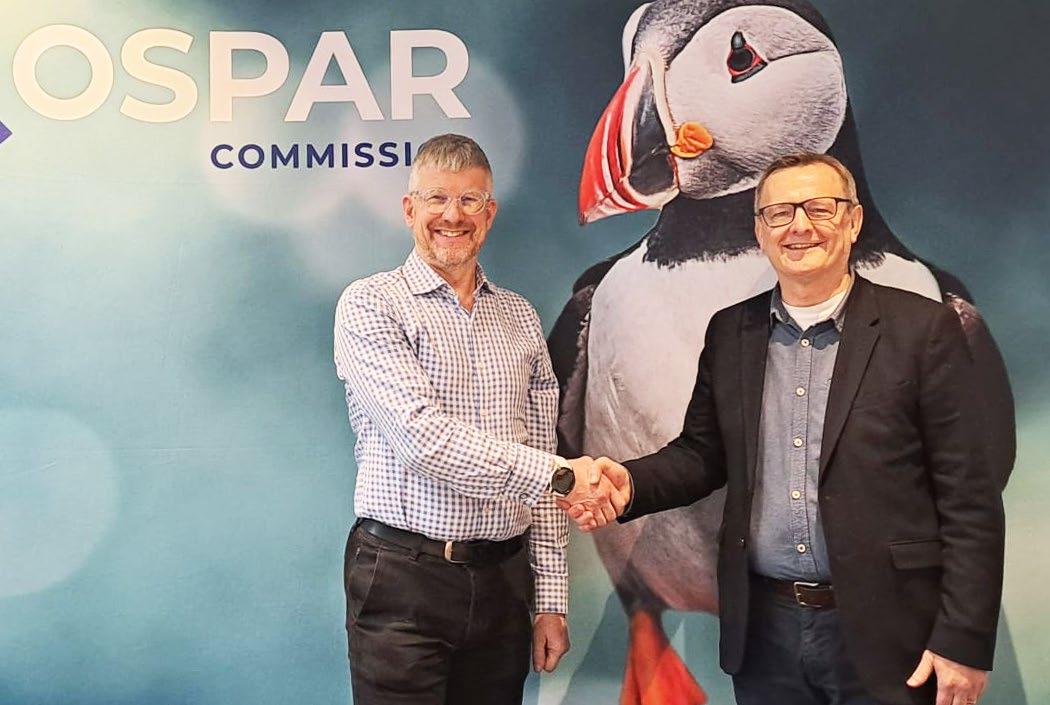
“The new technology will allow OSPAR to better consolidate and understand its data”

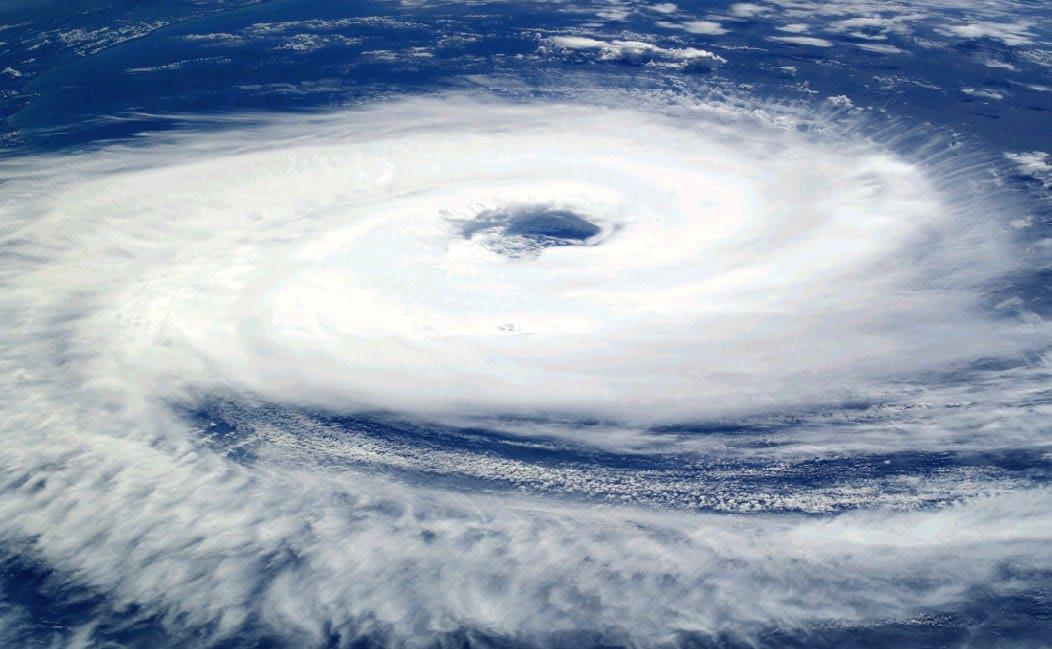
When cyclones approach the North-West Shelf of Australia, energy operators face critical decisions about their subsea infrastructure. The key to effective response lies in thorough preparation – and this is where SEA Global’s expertise makes a valuable difference.
Success in managing subsea assets through cyclone events depends on having comprehensive, current data about asset capacity and condition. SEA Global’s multi-disciplinary team works with clients year-round to maintain detailed digital records of infrastructure capabilities, creating a robust foundation for rapid decision-making when severe weather threatens.
The ICE Platform, SEA Global’s in-house automation toolkit, transforms this preparatory work into actionable intelligence during cyclone events. By automating complex engineering analyses, the platform enables:
l Rapid assessment of cyclone impacts based on actual storm paths and intensities
l Precise comparison of experienced loads against known asset capacities
l Risk-based prioritisation of inspection and repair activities
l Delivery of actionable insights faster than vessel mobilisation
SEA Global’s multi-disciplinary team brings together structural, marine, and subsea engineering expertise with advanced computational capabilities. This combination, enhanced by ICE Platform automation, enables clients to respond to cyclone events with unprecedented speed and precision.
Clients across the North-West Shelf rely on SEA Global as their trusted partner for cyclone season preparation and response. The combination of expert engineering, advanced technology, and deep regional experience ensures that when cyclones threaten, operators can make informed decisions quickly and allocate resources effectively. This integrated approach – expert teams equipped with powerful automation tools, building on thorough preparation – delivers the rapid, precise response that subsea infrastructure operators need during challenging weather events.
SEA Global is a pioneering engineering and project delivery firm headquartered in Perth Australia, with offices in Gdańsk, Poland. Operating on major projects globally, the company combines cuttingedge automated engineering workflows with project execution expertise to tackle complex infrastructure challenges, with specialist skills in upstream and midstream oil & gas engineering, and renewable energy infrastructure.


The latest update meeting for the Rock Bag JIP Phase II was held in December 2024 with representatives from UK, Europe, and Western Australia. The participants were updated on the completed dry testing scope, and the first stage of wet testing, which involved consideration of rock bags (Filter Units) on erodible seabeds.
The dry testing of the mass transfer of a model rock
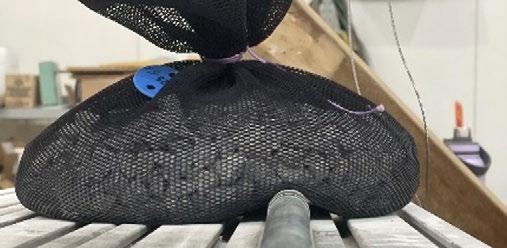
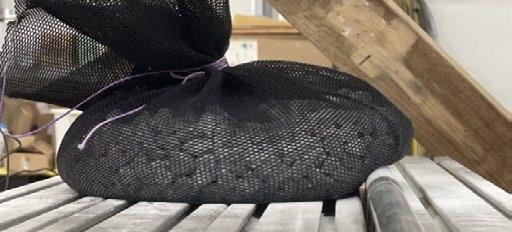
(b) Offset = 40% RB Diameter
bag (RBs) to a cable was undertaken at UWA’s Coastal Offshore Engineering Laboratory (COEL). The testing considered effects due to RB fill ratio, fill material, multi-bag configurations, and placement tolerances over a range of model cable diameters. This builds knowledge of the application of RBs as secondary stabilisation for cables and CPS subsea. This involved some 1700 individual tests. These tests have provided valuable quantitative data on RB performance that can be integrated with the failure envelopes developed previously.
The testing builds upon earlier work in which a strong focus was given towards developing new insights into the hydrodynamic behaviour of RBs under various flow conditions. This led to the development of a RB and cable failure envelopes for which the point of failure could be predicted given a flow velocity, or cable load imposed on the RB.
The figure below presents measured failure envelopes for two types of RB’s. Increasing the hydrodynamic loading reduces the cable load required to induce failure. Interestingly, multiple failure mechanisms were observed, occurring under varying hydrodynamic loading and cable loading relationships, as well as being influenced by the surface roughness and intrinsic properties of the RB model.




This scope of work is focused on the influence of sediment transport on the stability of a RB, with assessments being made on infiltration rates, scour profile developments, and stability of RB near scour holes. The test scope includes:
l Coefficient of friction testing to update current industry assumptions
l Infiltration assessment under varying flow conditions modelling both clear water and live bed scour conditions.
l Scaling assessment for post processing of data
l Modelling of scour profiles using photogrammetry techniques developed under the varying flow conditions.

l Influence on the hydrodynamic stability of the RBs models, measured through assessing the RBs critical velocity.
l Assessing multibag RB configurations
l Assessing the stability of a rock bag in proximity to pre-existing scour holes.
Upcoming testing will focus on measuring the hydrodynamic coefficients of isolated RBs, RBs on cables, and multibag RB configurations. With currently seven participants (Bluemont Australia, CRP, DEME, Nexans, JDN, Ridgeway Rockbags®, TenneT, Van Oord), the JIP would welcome the addition of further participants. Please contact AOE if you would like further information on this JIP, or on how to join it.
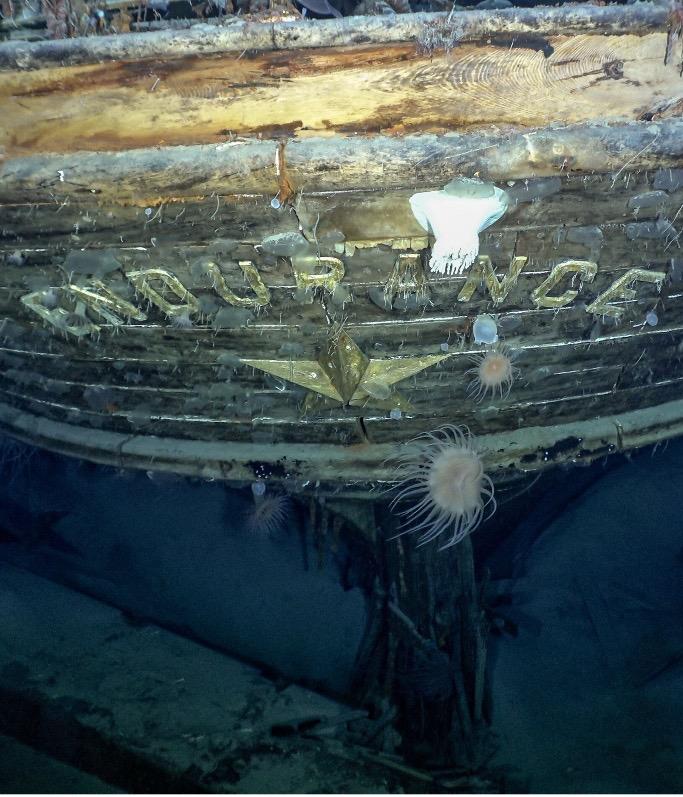
Voyis and the Falklands Maritime Heritage Trust reveal unprecedented details of the legendary vessel using advanced optical technology.
the historic Endurance shipwreck. Captured using the cutting-edge Voyis Observer Imaging System, this latest image provides an unparalleled view of the vessel and the seabed, revealing intricate details with clarity never seen before.
The level of detail we can now see allows us to deepen our understanding of Endurance’s condition and better appreciate the remarkable state of preservation of this legendary vessel.”
Building on a previously released image of Endurance, this new capture showcases the ship’s preserved structure with remarkable precision, made possible through Voyis’ True Colour technology. Unlike traditional underwater imaging, which can suffer from colour distortion and reduced visibility, the Voyis Observer Imaging System accurately restores the shipwreck’s natural hues and textures, offering a more authentic representation of how Endurance appears in its final resting place beneath the Weddell Sea.
Since red wavelengths are absorbed more rapidly by

water, the perceived colour of underwater objects is significantly altered. Standard cameras do not compensate for this underwater colour shift, as their colour formation models neglect the strong wavelength dependency of light in a submerged environment. As a result, shipwrecks and subsea assets often appear with unnatural blue or green tints.
Voyis’ True Colour technology addresses this challenge by leveraging machine learning to efficiently train a Colour Correction Model for the current survey location. This survey-grade imaging solution corrects the distortions caused by underwater light absorption, producing images that represent colours as they would be perceived in air. This advancement allows explorers to visualize the true colour of subsea assets, uncovering fine details that standard cameras fail to capture.
“This new image is a testament to the evolution of

Over one hundred years after its wreck, Endurance, Sir Ernest Shackleton’s ship, was found in the depths of the most hostile sea on Earth. The Ship Beneath the Ice is the astonishing story of the ship and its discovery, told by Mensun Bound, the Director of Exploration on the Endurance22 Expedition.
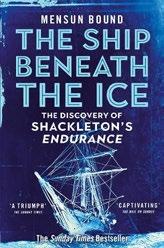
‘The story of Shackleton’s Endurance is one of the most extraordinary in the history of exploration. This is more than just an astonishing sequel. It is a tale just as powerful, and one which redefines the meaning of impossible’ – Sir Michael Palin CLICK HERE to get the book.
underwater exploration technology,” said Elena Lewendon, COO at the Falklands Maritime Heritage Trust. “The level of detail we can now see allows us to deepen our understanding of Endurance’s condition and better appreciate the remarkable state of preservation of this legendary vessel.”
Voyis’ Observer Imaging System was designed to overcome the challenges of deep-sea imaging by delivering high-resolution optical data with true colour fidelity. By eliminating artificial lighting inconsistencies and improving image sharpness, this system sets a new benchmark for underwater archaeology and heritage preservation.
“Voyis is honoured to have contributed to the exploration of Endurance,” said Luke Richardson, VP Sales & Marketing at Voyis. “Our Observer Pro Imaging System, with true colour correction, allows us to see the wreck as it truly is, preserving its legacy with the highest level of accuracy possible.”
This latest image serves as a powerful reminder of Endurance’s enduring story, a tale of resilience, exploration, and the boundless capabilities of modern technology in uncovering the past.


A century after Shackleton’s Endurance sank beneath the ice, explorers uncover the legendary shipwreck and an amazing tale of survival.
WATCH NOW

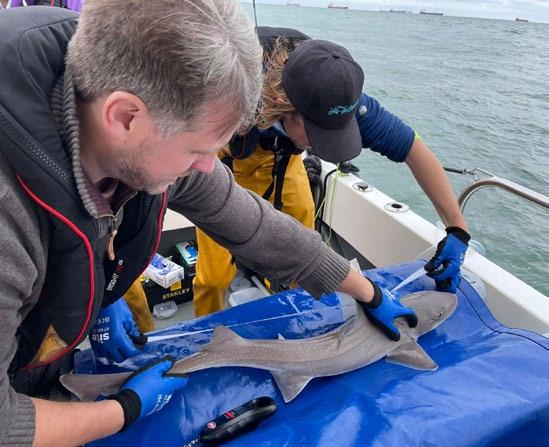

As we strive to protect 30% of the ocean by 2030, the lessons learned from the UK’s best example of a continuous, long-term Marine Protected Area monitoring study are clear – conservation works best when it’s inclusive, grounded in evidence, and designed to meet the needs of both ecosystems and people. Insights from two University of Plymouth initiatives are shaping the future of marine conservation: the Lyme Bay monitoring programme and the Fish Intel under water acoustic receiver network. These projects highlight how evidencebased approaches can drive ecological recovery while benefiting fisheries and coastal communities.
Since 2008, the Lyme Bay Marine Protected Area has been protected from bottom-towed fishing, creating space for the ecosystem to recover. Over 16 years of continuous annual monitoring, we’ve seen remarkable ecological gains: reef species abundance has increased by 95%, and fish diversity and abundance are up to 400% higher compared to unprotected areas.
These ecological advances suggest the potential for broader benefits, including burgeoning fish populations that can contribute to sustainable fisheries in surrounding areas. The recovery of commercially valuable species such as lobster and scallops within the protected area demonstrates the value of safeguarding marine habitats for biodiversity and livelihoods alike. By taking a whole-site approach—protecting the entire ecosystem rather than focusing on individual features—we’ve shown how conservation can support
Dr Emma Sheehan, from the University of Plymouth, has been researching the ecological impacts of the Lyme Bay Marine Protected Area since 2008, in what is considered to be the best example of a continuous long-term MPA monitoring study in the UK.

Now, Dr Sheehan, together with ‘Ropes to Reefs’ Project Manager Amy Cartwright, gives her thoughts on lessons learned from this wholesite approach to marine conservation, and how state-of-the-art sensor technology can provide the evidence needed to drive ecological recovery for the benefit of fisheries and communities.
both ecological restoration and the resilience of coastal communities. Lyme Bay offers a hopeful model for balancing marine protection with sustainable resource use.
The Fish Intel Network expands on the local focus of our Lyme Bay monitoring by exploring how marine species move across larger areas. Using around 200 underwater receivers and data from over 1,500 tagged fishes and crustaceans, our acoustic telemetry is uncovering patterns in the movements of species like European bass, pollack, rays and
This isn’t just about funding research; it’s about ensuring the resilience of marine ecosystems and the wellbeing of the communities that rely on them.

lobster along the south coast of the UK and beyond. Crucially, the work involves close collaboration with local fishing communities and by working together we have identified 13 million individual animal detections across six years of continuous data. This information is vital for effective fisheries management. By identifying critical habitats, migration routes and seasonal behaviours, we can inform ambitious management and policy that align with the natural rhythms of marine species. For example, protecting spawning and nursery grounds at the right time to help safeguard key life stages while supporting sustainable fishing practices.
Despite the progress made, the future of the Lyme Bay project and the Fish Intel Network remains uncertain due to funding challenges. Long-term monitoring and telemetry projects need consistent support to maintain their impact. Without it, we risk losing the data that underpins effective conservation and fisheries management.
This isn’t just about funding research; it’s about ensuring the resilience of marine ecosystems and the wellbeing of the communities that rely on them. Looking ahead, it will be vital to consider how we can continue to support projects like these to secure a sustainable future for our oceans and coastal communities.
The installation of pin piles is a critical component of jacket foundation installation, providing the necessary stability for wind turbines. Achieving an optimal installation method requires a holistic approach that considers various factors, including project-specific details, vessel capabilities and installation efficiency. This article explores these factors in detail to help determine the best installation method for pin piles.
Every offshore wind project is unique, with specific requirements and challenges that must be addressed. Key project-specific details include the location, water depth, soil conditions, and environmental factors. Understanding these details is crucial for selecting the appropriate installation method.
l Location: The geographical location of the project influences the choice of installation method. For example, projects in regions with high seismic activity and chances of typhoons, such as Taiwan or Japan, may require more robust foundation designs and installation techniques to withstand potential earthquakes and extreme wind loads. Additionally, each country has its own regulatory framework. For example, Japan and the United States have protective legislation that restricts the operation of foreign vessels in their waters.
l Water depth: The depth of the water at the installation site affects the type of equipment and vessels needed. Shallow water installations may allow for the use of jack-up vessels, while deeper water projects might require floating vessels and specialized equipment. Floating vessels require self-leveling piling templates which are more complex than suspended templates underneath a jack-up vessel.

l Soil conditions: The seabed composition, including the type of soil and its bearing capacity, plays a significant role in determining the installation method. Detailed geotechnical surveys are essential to gather data on soil conditions, which can influence the choice of pin pile design and installation technique. For example, Taiwan’s offshore wind projects face challenges with low bearing soil conditions, while France’s diverse soil conditions range from sandy and silty soils to rocky seabeds. Low bearing soil conditions might results in challenging piling template seabed interface, while rocky seabeds require drilling solutions.
l Environmental factors: Weather conditions, wave and current patterns, and the presence of marine life can impact the installation process. For instance, larger pin piles tend to vibrate with lower wave frequencies, which can affect the installation operability. Conducting motion analyses or workability analyses is essential to account for these factors and ensure a safe and efficient installation.



The capabilities and availability of installation vessels are critical considerations in the installation process. Different vessels have varying capacities, equipment, and operational limits, which can affect the feasibility and cost of the installation method.
l Vessel type: The choice of vessel depends on the project requirements and site conditions. Jackup vessels are commonly used for shallow water installations, providing a stable platform for pile driving. Floating vessels, on the other hand, are suitable for deeper waters and can accommodate larger equipment.
l Vessel availability: The availability of suitable vessels can impact the project timeline and costs. A shortage of specialized vessels can lead to delays and increased expenses. Past installation methods, primarily reliant on Jack-Up Vessels (JUVs), have proven effective but are currently facing limitations in handling the demands of longer, larger, and heavier piles. However, the shortage of heavy lift vessels capable of installing these larger pin piles is a pressing concern.
l Operational costs: The cost of operating installation vessels includes fuel, crew, and maintenance expenses. These costs can vary significantly depending on the vessel type and the duration of the installation process. Optimizing installation sequence and minimizing
downtime can help reduce overall costs.
Efficiency in the installation process is crucial for minimizing project timelines and costs. Several factors contribute to installation efficiency, including the choice of equipment, installation techniques, and project management.
l Tailored installation equipment: The selection of installation equipment, such as pin pile templates and lifting devices, can impact the speed and accuracy of the installation. Tailoring equipment design to the specific needs of the project can enhance efficiency.
l Installation method: Different installation methods, such as pile driving and drilling have varying levels of efficiency and suitability for different soil conditions. Selecting the right method based on project-specific details can improve installation efficiency.
l Project management: Effectively managing the project’s budget, planning, risk control, QHSE requirements, and procurement, along with detailed project management practices such as planning, scheduling, and coordination, is essential for ensuring smooth project execution. Real-time monitoring and adjustments can help address any issues that arise during installation, minimizing delays and disruptions.



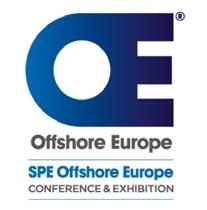
Adapted from an article by David Whitehouse, SPE Offshore Europe 2025 Executive Committee Chair and Chief Executive, Offshore Energies UK
In just a few months, Aberdeen will once again host SPE Offshore Europe 2025 (OE25), the premier offshore energy event in Europe. Building on the success of the 2023 conference, OE25 will focus on “Unlocking Europe’s Potential in Offshore Energy.”
As we approach September, the early months of 2025 will be pivotal for shaping the future of the UK’s offshore energy sector and its climate goals. Our industry is part of a global community striving to deliver cleaner energy, and OE25 will play a critical role in facilitating collaboration, innovation, and action. The event highlights the expertise of the 200,000 professionals working in the UK’s world-class offshore industry, including operators, developers, and supply chain partners.
Planning for OE25 is well underway, with a robust technical and executive programme that includes 12 strategic panel sessions, fireside chats with high-profile guests, and a focus on fostering diverse voices. Young professionals will gain valuable experience through opportunities to speak, moderate, and engage in panel discussions. Events for school pupils, university students, and new entrants will further strengthen future talent pipelines.
A key shift this year is to emphasise Europe’s central role in offshore energy. Offshore energy extends beyond the North Sea, touching lives across the continent. OE25 will
bring together diverse perspectives from various nations, fostering a collaborative environment where industry leaders exchange knowledge and best practices. Keynote speakers will share insights into how different countries manage their energy transitions and approach energy security.
OE25 aims to shift the conversation from rhetoric to realworld action. Supply chain opportunities in the energy transition have been widely discussed, but now it’s time for tangible progress. A major focus will be on accelerating carbon storage implementation and making it commercially viable. The conference will explore ways to drive down costs and scale solutions effectively.
The UK offshore energy sector is evolving, not declining. OE25 will highlight emerging technologies such as offshore wind, hydrogen, and carbon capture and storage (CCUS), showcasing new business models that will shape the industry’s future. The decisions made leading up to OE25 will impact jobs, communities, and companies across Europe, making it a catalyst for change.
OE25 is more than just a conference—it’s a platform to foster international collaboration, encourage open debate, and push for actionable solutions. By reigniting confidence in the North Sea energy sector and beyond, OE25 will reaffirm Aberdeen’s position at the heart of the global offshore energy industry.
Register your interest: Search Offshore Europe.
29 January 2025 | Lloyd Warwick, London |
Iain Knight
The London and South of England branch of the SUT were excited to start their 2025 programme of events with an evening looking at the challenges of offshore floating wind farms. We had assembled three industry experts to talk on some of the marine challenges associated with floating wind developments: these being:
• ‘Site Investigation and Anchoring for Floating Offshore Wind – The MA17 Project’ by Jordan Geear CGeol FGS, Global Business Lead – Engineering Geology, Global Maritime
• ‘Dynamic Array Cable Configurations’ by John Willcocks, Technical Director, Wood
• ‘The Application of Machine Learning to predict the Fatigue Performance of Floating Wind Foundations’ by Nick Allen, Principal Naval Analysis Engineer, Saipem

All three presentations were well received and were each followed by an animated Q&A session.
As usual after our technical presentations, we decamped to a local hostelry in Leadenhall for further technical discussions and re-acquainting with old and new friends.
Please look out for further evening events and lunch and learns organised by the London and SE branch of the SUT. From the rapid ticket sales and packed venue, the energy transition and offshore floating wind are obviously subjects of interest to our members and we will try to revisit them later this year.
A big thanks to our friends at Lloyd Warwick International for hosting us on the night.

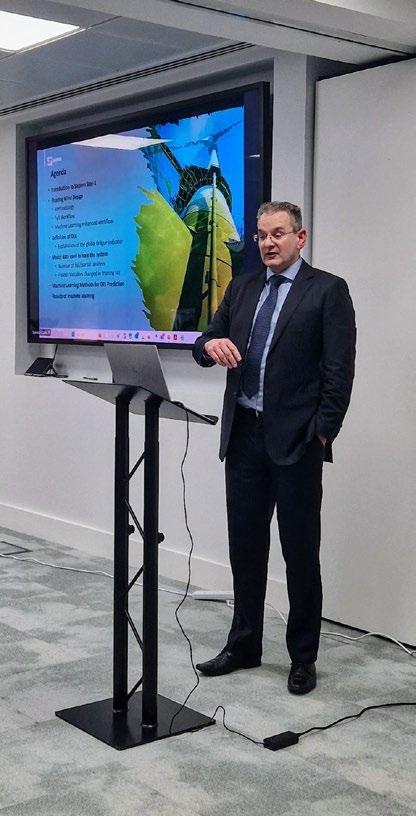
27 January 2025 | OGV Podium, Aberdeen | Andrew Connelly
Thursday 27 January 2025 saw the second annual SUT Aberdeen Branch Pub Quiz take place at OGV Podium. With 60+ attending, everyone’s sights were set on the questions set by Quizmaster Chris Wallace. The quizzing mood was immediately set with Chris arriving on stage adorned in a red sequined sparkling jacket!
Featuring eight rounds including General Knowledge, Music, Geography, Scottish Phrases, and Answer Mashup, knowledge was well tested!
The quiz took a half time break for pizza, a chance to replenish drinks, to catch up with others at the event, and to cover an AGM for the Aberdeen Branch. Included was an overview of 2024 activities, plans for 2025, and an update on the branch committee. Joining the committee are Bill Gray (Shell), Scott Robbie (Ashtead Technology), and Emeka Oti (BP). Elected to voting status are Scott Duncan (2H Offshore) and Louise Mearns (ROSEN). Stepping down as branch chair is Andrew Connelly (Imenco) after two years in the role, stepping up as new branch chair is Graham Whitehead (Crondall Energy). Best of luck, Graham!
Once answers sheets were submitted and scores added up, there was one team who were clear winners… “VIG (Very Important Geologists)”. Commiserations to The Subsea Snipers (Team SUT+) who picked up the wooden spoon, better luck next year guys!
Special thanks to Chris’ partner, Kate, who helped with professionally adding up the scores. We look forward to next year’s quiz and seeing what rounds will face the quizzers, make sure you are there to find out!
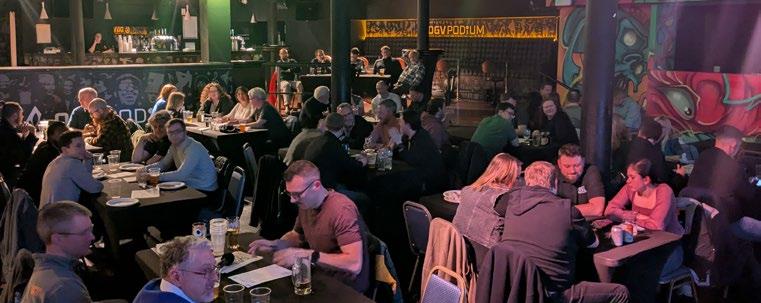



4 February 2025 | Marcliffe Hotel, Aberdeen |
Martin Harley

A total of 44 attendees joined us very early on a mild February morning at the Marcliffe at Pitfodels Hotel in Aberdeen for the Society’s 2025 Business Breakfast & Market Outlook, titled High Stakes.
Once again, our speakers were James Hall of Axiom EMI, Catherine MacFarlane, and Ross Macdonald of S&P Global. They revisited some of their predictions from a year ago, updating us with new information in the wake of the UK and US elections. Indeed, we were pleased to see some familiar faces in the audience from last year and presume this is because our speakers are saying the right kind of thing.
Chair Martin Harley opened the event, setting the scene with a few recent developments that served as a backdrop to the two talks we were about to hear. He covered topics including the fall of the Norwegian government, triggered by a tenfold increase in energy prices due to the need to supply gas to a Europe that refused to produce its own; the fact that European gas storage was abnormally low in a winter that has not yet finished; and the contradiction between claims that renewables are cheap and data showing that UK wind farms funded by Contracts for Difference received more revenue from subsidies than from selling the electricity they generated.
James Hall of Axiom EMI presented a number of oil price and CAPEX predictions from various analysts, banks, and international NGOs. He then outlined his current confidence in Net Zero becoming a reality by 2050 before moving on to the global renewables buildout, oil and gas tree, fixed and floating installations, and commentary on overall offshore spending across both fossil and renewable sectors. He demonstrated that, from a variety of perspectives, the energy industries were in robust health and likely to remain so.
Catherine MacFarlane and Ross Macdonald of S&P Global both covered the global fleet, starting with a review of Diving Support Vessels before moving through a variety of other construction and offshore support vessels. The overall picture was one of reduced DSV availability but an increase in construction support vessels, meaning we should expect rates to change accordingly. Meanwhile, vessels built specifically for the wind industry have become a competitive option for oil and gas services.
All three speakers delivered information-dense analyses of the offshore energy markets, and we would like to thank each of them for continuing to speak on the SUT’s behalf.
12 February 2025 | Aberdeenshire Cricket Club | Graham Whitehead
The Aberdeen Branch recently welcomed around 60 attendees, representing a broad cross-section of experience, to Aberdeen Cricket Club for an evening meeting on Diving – Research, Practice and Safety.
Graham Whitehead opened the meeting, highlighting that while remote technologies are commonly used in underwater operations, manned diving remains essential across the globe, with over 70 dive support vessels (DSVs) currently active. He noted the risk of hard-earned knowledge being lost as the average age of saturation divers increases. This meeting was therefore designed to share expertise among current practitioners while also informing attendees less familiar with diving operations.
Bill Chilton of IMCA shared insights from a North Sea diving incident, drawing lessons for underwater cutting operations. His talk reflected on a commercial diving incident that occurred during a subsea decommissioning project while he was at the UK’s Health & Safety Executive. The presentation examined what went wrong, what could have been done differently, and how the incident influenced changes in the UK commercial diving industry. Some attendees were already familiar with the event and its findings, agreeing that lessons had been learned. The speaker also explained how he had presented these lessons to dive teams in other global regions unfamiliar with the incident, reinforcing the continued need for experiential knowledge sharing.
Graeme Robb of JFD Group covered the topic of modern hyperbaric rescue facilities, which are critical safety systems for saturation divers in the event of an emergency evacuation from a DSV. Thankfully, no operational incident has ever required the deployment of such facilities. However, given the complexity
and life-threatening nature of such an operation, technological advancements—such as mobile decompression facilities—are continually improving safety measures.
Mario Gagliardini of Boskalis Subsea Services delivered an eye-opening presentation on the challenges divers face if they need to perform CPR on a colleague inside a diving bell at depth. In collaboration with doctors and resuscitation professionals from Derby University Hospital, a new method known as the Dunoon Protocol has been developed using the latest medical practices. This approach has recently undergone trials and is expected to become a cornerstone of saturation diver safety and industry standards. The presentation also covered ongoing research into enhancing recovery systems and the potential use of defibrillators in diving bells.
Calum Miller of BP presented a case study from a recent diving campaign, illustrating the complexities of mid-water diving. His talk covered key operational challenges, including DSVs operating in close proximity to fixed installations, complex rigging arrangements, and the control and communication required during load transfer activities. Success factors included methodical and detailed risk assessments, the use of 3D visualisation to design rigging and familiarise crews with the complexities of in-water activities, and effective SIMOPS coordination between the vessel and platform.
Graham Whitehead closed the meeting by thanking the speakers and attendees for braving the cold February evening. The turnout and high level of engagement underscored the ongoing need for collaboration and knowledge-sharing within the commercial diving community.


We’re looking for SUT member-written articles focussing on INNOVATION and on the BLUE ECONOMY.

• Welcome from the CEO
• Welcome to new Corporate Members Global Branch updates Special Interest Groups
• Spotlight article(s) on innovation
• Spotlight article(s) on the blue economy
• SUT News
• SUT Member news
Additionally, if you are a corporate member and have a short update you’d like to include please contact Emily Boddy for details on how to get your company news included in the SUT newsletter. Issues will be quarterly and can include: NEXT issue June 2025
• Young Professionals International
• Corporate Member updates Photo Galleries SUT Events/Training/Podcast
• SUT Member Benefits
• Industry updates
• ...and much more...
We value our members and your contribution is very important to us at the SUT
If you would like to contribute to any of the above features, as an individual member or corporate member please contact our editor Michelle Jones, SUT Publications & Communications Officer - michelle.jones@sut.org
Deadline for submissions - 16th May 2025